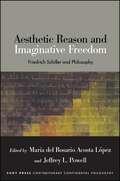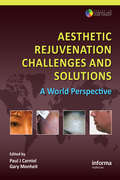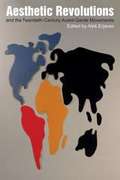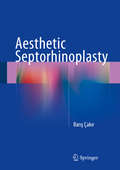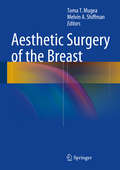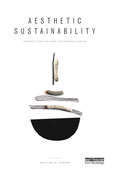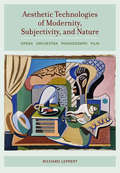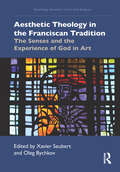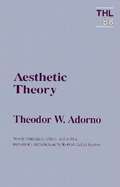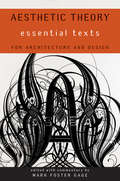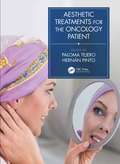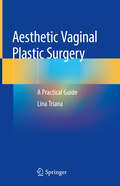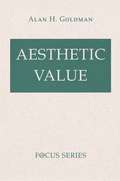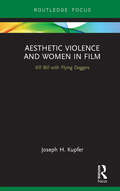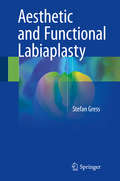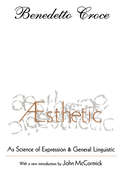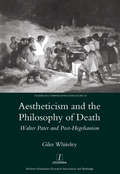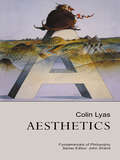- Table View
- List View
Aesthetic Reason and Imaginative Freedom: Friedrich Schiller and Philosophy (SUNY series in Contemporary Continental Philosophy)
by María del Rosario Acosta López; Jeffrey L. PowellThis book seeks to draw attention to Friedrich Schiller (1759–1805) as a philosophical thinker in his own right. For too long, his philosophical contribution has been neglected in favor of his much-deserved reputation as a political playwright. The essays in this collection make two arguments. First, Schiller presents a robust philosophical program that can be favorably compared to those of his age, including Rousseau, Kant, Schelling, and Hegel, and he proves to be their equal in his thinking on morality, aesthetics, and politics. Second, Schiller can also guide us in our more contemporary philosophical concerns and approaches, such as phenomenology, hermeneutics, aesthetics, and politics. Here, Schiller instructs us in our engagement with figures such as Walter Benjamin, Michel Foucault, Jacques Rancière, Roberto Esposito, and others.
Aesthetic Rejuvenation Challenges and Solutions: A World Perspective (Series in Cosmetic and Laser Therapy)
by Paul J Carniol Gary D MonheitPractitioners of aesthetic medicine and surgery already have a series of textbooks instructing on how to treat the standard patient. Unfortunately, they also have patients who do not conform to the average-those who are of a different age, or sex, ethnicity, or medical history, or who have special social requirements. Aesthetic Rejuvenation Challen
Aesthetic Revolutions and Twentieth-Century Avant-Garde Movements
by Aleš ErjavecThis collection examines key aesthetic avant-garde art movements of the twentieth century and their relationships with revolutionary politics. The contributors distinguish aesthetic avant-gardes --whose artists aim to transform society and the ways of sensing the world through political means--from the artistic avant-gardes, which focus on transforming representation. Following the work of philosophers such as Friedrich Schiller and Jacques Rancière, the contributors argue that the aesthetic is inherently political and that aesthetic avant-garde art is essential for political revolution. In addition to analyzing Russian constructivsm, surrealism, and Situationist International, the contributors examine Italian futurism's model of integrating art with politics and life, the murals of revolutionary Mexico and Nicaragua, 1960s American art, and the Slovenian art collective NSK's construction of a fictional political state in the 1990s. Aesthetic Revolutions and Twentieth-Century Avant-Garde Movements traces the common foundations and goals shared by these disparate arts communities and shows how their art worked towards effecting political and social change. Contributors. John E. Bowlt, Sascha Bru, David Craven, Aleš Erjavec, Tyrus Miller, Raymond Spiteri, Miško Šuvakovic
Aesthetic Science: Representing Nature in the Royal Society of London, 1650-1720
by Alexander Wragge-MorleyThe scientists affiliated with the early Royal Society of London have long been regarded as forerunners of modern empiricism, rejecting the symbolic and moral goals of Renaissance natural history in favor of plainly representing the world as it really was. In Aesthetic Science, Alexander Wragge-Morley challenges this interpretation by arguing that key figures such as John Ray, Robert Boyle, Nehemiah Grew, Robert Hooke, and Thomas Willis saw the study of nature as an aesthetic project. To show how early modern naturalists conceived of the interplay between sensory experience and the production of knowledge, Aesthetic Science explores natural-historical and anatomical works of the Royal Society through the lens of the aesthetic. By underscoring the importance of subjective experience to the communication of knowledge about nature, Wragge-Morley offers a groundbreaking reconsideration of scientific representation in the early modern period and brings to light the hitherto overlooked role of aesthetic experience in the history of the empirical sciences.
Aesthetic Septorhinoplasty
by Barış ÇakırThis superbly illustrated book describes how techniques previously developed by Dr. Rollin Daniel for use in open rhinoplasty can be adapted for use in the closed approach. It is the author's opinion that this combination offers greater feedback during surgery, a shorter recovery period and absence of scar. Full explanation is provided of preoperative preparation, including evaluation of the nasal surface aesthetics using the concept of geometric polygons as aesthetic subunits to define both the existing deformity and the aesthetic goals. The surgical techniques developed and modified to achieve the desired surface appearance are then described step by step with the aid of a wealth of color photos. It is illustrated how the novel dissection and redrape control methods reduce the healing time and enhance outcome and an extensive series of case analyses is presented to document the benefits of the approach. The book is written in a "cookbook format" that will enable plastic surgeons quickly to learn how to utilize the closed approach to rhinoplasty to optimal aesthetic benefit.
Aesthetic Septorhinoplasty
by Barış ÇakırThis extensively revised second edition describes how techniques previously developed by Dr. Rollin Daniel for use in open rhinoplasty can be adapted for the closed approach. The author argues that this offers greater feedback during surgery, a shorter recovery period and absence of scarring. The book includes a full explanation of preoperative preparation, including evaluation of the nasal surface aesthetics using the concept of geometric polygons as aesthetic subunits to define both the existing deformity and the aesthetic goals. Aided by a wealth of color photos, it also provides step-by-step descriptions of the surgical techniques developed and modified to achieve the desired surface appearance, and illustrates how the novel dissection and redrape control methods reduce the healing time and enhance outcomes. Further, the book presents a series of case analyses documenting the benefits of the approach. Written in a “cookbook style" this superbly illustrated book enables plastic surgeons to quickly learn how to utilize the closed approach to rhinoplasty for optimal aesthetic benefit.
Aesthetic Surgery of the Breast
by Melvin A. Shiffman Toma T. MugeaThis book covers all aspects of aesthetic breast surgery in an instructive, step-by-step format. The descriptions of procedures are completely up to date, encompassing newly introduced techniques and recent modifications of established techniques. Individual parts of the book are devoted to breast augmentation, mastopexy, and breast reduction. Detailed consideration is also given to risks and complications, with guidance on their avoidance and the treatment of complications. In addition, anatomy, anesthesia, and a range of miscellaneous procedures applicable in specific circumstances are all well covered The authors are acknowledged experts in their fields who draw on a wealth of experience in describing and illustrating their personally favored techniques. Aesthetic Surgery of the Breast will be an ideal reference for both students (residents and fellows) and practicing cosmetic, plastic, and general surgeons.
Aesthetic Surgery of the Buttock: A Comprehensive Clinical Guide
by Daniel Del Vecchio Héctor DuránIn the past five years, buttock surgery has been changing and expanding worldwide, while also attracting media attention. Surgeons have been confronted with a shocking number of requests for buttock augmentation surgeries. Further, as patients become more complex, more complex procedures are called for, such as fat infiltration surgery combined with implants or, for example, modifying the waist-to-hip ratio.Aesthetic Surgery of the Buttock is the first book of its kind, covering all relevant aesthetic issues. It offers essential guidance on performing surgery, but also on avoiding complications due to fat infiltration in large blood vessels and thus avoiding embolisms at the pulmonary level. In addition, much of the book addresses various aspects of fat infiltration, e.g. obtaining, processing and applying this fat. It also discusses implants, which are an excellent option for many patients, as well as new trends in the combination of fat infiltration and implants to achieve more natural results. Given its scope, it represents an invaluable asset for all plastic surgeons around the globe who perform body-contouring surgeries.
Aesthetic Sustainability: Product Design and Sustainable Usage (Routledge Studies in Sustainability)
by Kristine H. HarperWhy do we readily dispose of some things, whereas we keep and maintain others for years, despite their obvious wear and tear? Can a greater understanding of aesthetic value lead to a more strategic and sustainable approach to product design? Aesthetic Sustainability: Product Design and Sustainable Usage offers guidelines for ways to reduce, rethink, and reform consumption. Its focus on aesthetics adds a new dimension to the creation, as well as the consumption, of sustainable products. The chapters offer innovative ways of working with expressional durability in the design process. Aesthetic Sustainability: Product Design and Sustainable Usage is related to emotional durability in the sense that the focus is on the psychological and sensuous bond between subject and object. But the subject–object connection is based on more than emotions: aesthetically sustainable objects continuously add nourishment to human life. This book explores the difference between sentimental value and aesthetic value, and it offers suggestions for operational approaches that can be implemented in the design process to increase aesthetic sustainability. This book also offers a thorough presentation of aesthetics, focusing on the correlation between the philosophical approach to the aesthetic experience and the durable design experience. The book is of interest to students and scholars working in the fields of design, arts, the humanities and social sciences; additionally, it will speak to designers and other professionals with an interest in sustainability and aesthetic value.
Aesthetic Technologies of Modernity, Subjectivity, and Nature: Opera, Orchestra, Phonograph, Film
by Richard LeppertVirginia Woolf famously claimed that, around December 1910, human character changed. Aesthetic Technologies addresses how music (especially opera), the phonograph, and film served as cultural agents facilitating the many extraordinary social, artistic, and cultural shifts that characterized the new century and much of what followed long thereafter, even to the present. Three tropes are central: the tensions and traumas--cultural, social, and personal--associated with modernity; changes in human subjectivity and its engagement and representation in music and film; and the more general societal impact of modern media, sound recording (the development of the phonograph in particular), and the critical role played by early-century opera recording. A principal focus of the book is the conflicted relationship in Western modernity to nature, particularly as nature is perceived in opposition to culture and articulated through music, film, and sound as agents of fundamental, sometimes shocking transformation. The book considers the sound/vision world of modernity filtered through the lens of aesthetic modernism and rapid technological change, and the impact of both, experienced with the prescient sense that there could be no turning back.
Aesthetic Theology in the Franciscan Tradition: The Senses and the Experience of God in Art (Routledge Research in Art and Religion)
by Xavier Seubert Oleg BychkovThe book investigates the aesthetic theology embedded in the Franciscan artistic tradition. The novelty of the approach is in applying concepts gleaned from Franciscan textual sources to create a deeper understanding of how art in all its sensual forms was foundational to the Franciscan milieu. Chapters range from studies of statements about aesthetics and the arts in theological textual sources to examples of visual, auditory, and tactile arts communicating theological ideas found in texts. The essays cover not only European art and textual sources, but also Franciscan influences in the Americas found in both texts and artifacts.
Aesthetic Theory
by Theodor W. AdornoPerhaps the most important aesthetics of the twentieth century appears here newly translated, in English that is for the first time faithful to the intricately demanding language of the original German. The culmination of a lifetime of aesthetic investigation, Aesthetic Theory is Theodor W. Adorno's magnum opus, the clarifying lens through which the whole of his work is best viewed, providing a framework within which his other major writings cohere. Translated by Robert Hullot-Kentor.
Aesthetic Theory: Construction Of The Aesthetic (Theory and History of Literature #88)
by Theodor W. AdornoPerhaps the most important aesthetics of the twentieth century appears here newly translated, in English that is for the first time faithful to the intricately demanding language of the original German.The culmination of a lifetime of aesthetic investigation, Aesthetic Theory is Adorno&’s major work, a defense of modernism that is paradoxical in its defense of illusion. In it, Adorno takes up the problem of art in a day when &“it goes without saying that nothing concerning art goes without saying.&” In the course of his discussion, Adorno revisits such concepts as the sublime, the ugly, and the beautiful, demonstrating that concepts such as these are reservoirs of human experience. These experiences ultimately underlie aesthetics, for in Adorno&’s formulation &“art is the sedimented history of human misery.&”Robert Hullot-Kentor&’s translation painstakingly, yet fluently, reproduces the nuances and particularities of the original. Long awaited and significant, Aesthetic Theory is the clarifying lens through which the whole of Adorno&’s work is best viewed, providing a framework within which his other major writings cohere.
Aesthetic Theory: Essential Texts
by Mark Foster GageA collection of pivotal ideas about beauty from throughout history, with an introduction and critical headnotes. This collection of writings on beauty includes selections from twenty key philosophers and theoreticians spanning two millennia: Plato • Aristotle • Vitruvius • Alberti • Kant • Burke • Fiedler • Nietzsche • Wilde • Bergson • Bell • Scott • Benjamin • Bataille • Sontag • Jameson • Scarry • Nehamas • Zangwill • Freedberg and Gallese With an introduction and critical headnotes explaining the importance of each text, Mark Foster Gage offers a framework for a provocative history of ideas about beauty as they relate to contemporary thinking on architecture and design. In a world increasingly defined by sumptuous visuality, the concepts of beauty and visual sensation are not mere intellectual exercises but standards that define the very nature of design practice across disciplines and that are essential to the emerging worlds of design and architecture in the twenty-first century.
Aesthetic Treatments for the Oncology Patient
by Paloma Tejero and Hernán PintoPhysicians are increasingly recognizing that helping a cancer patient feel good about themselves and about their appearance can be of vital importance in giving them the emotional support and psychological resilience to survive and recover from the side-effects of disease and its treatment. Dermatologists and other aesthetic physicians are in a prime position to help a cancer patient recover lost volume, hydration, and pigmentation in skin, nails, and hair, as well as to advise on nutrition, prostheses, and complentary therapies. This pioneering volume will be an important resource bringing together the expertise in this area, with the practical detail a physician will need.
Aesthetic Vaginal Plastic Surgery: A Practical Guide
by Lina TrianaThis book schematically discusses the available techniques for aesthetic vaginoplasty, including vagina rejuvenation and other related surgical and non-surgical approaches. By furthering our understanding of the field, it promotes a better surgical practice on aesthetic vaginal surgeries. More specifically, this book will enable surgeons to correctly assess patients, choose and plan procedures, and reproduce the most common surgical aesthetic vaginal procedures.Each chapter is written in a pedagogical way, promoting a direct applicability. For each surgical procedure discussed, it features topics such as consultation and patient’s intentions, clinical examination, anatomy and important landmarks, surgical technique and possible complications. Aesthetic Vaginal Plastic Surgery: A Practical Guide is intended for any medical professional interested in vagina aesthetic and rejuvenation procedures, especially those in the fields of plastic surgery, gynecology and urology.
Aesthetic Value (Focus Series)
by Alan GoldmanAt the heart of aesthetics lie fundamental questions about value in art and the objectivity of aesthetic valuation. A theory of aesthetic value must explain how the properties of artworks contribute to the values derived from contemplating and appreciating works of art. When someone passes judgment on a work of art, just what is it that is happening, and how can such judgments be criticized and defended?In this concise survey, intended for advanced undergraduate students of aesthetics, Alan Goldman focuses on the question of aesthetic value, using many practical examples from painting, music, and literature to make his case. Although he treats a wide variety of views, he argues for a nonrealist view of aesthetic value, showing that the personal element can never be factored out of evaluative aesthetic judgments and explaining why this is so. At the same time, he argues for certain common effects of highly esteemed artworks.Along the way Goldman considers such key topics as interpretation, representation, expression, and taste. His text will be a valuable contribution to the teaching of aesthetics as well as to the understanding of these topics on the part of students and scholars in philosophy and the arts.
Aesthetic Violence and Women in Film: Kill Bill with Flying Daggers (Routledge Focus on Feminism and Film)
by Joseph H. KupferAesthetic Violence and Women in Film is a highly readable and timely analysis of the intersection of two recent cinematic trends in martial arts films: aesthetic violence and warrior women. Joseph Kupfer establishes specific categories of aesthetic film violence, including hyper-violence, a visual style that emphasizes the sensuous surface of physical destruction and surreal violence, when spectacular imagery and gravity-defying dance replace blood and gore. He then goes on to outline the ascendancy during the past decades of female characters to the status of hero in action films. Interweaving these two subjects, the book reveals how women warriors instigate and animate the models of aesthetic violence introduced. The hyper-violence of Kill Bill celebrates the triumphs of the Bride, whose maiming and dismemberment of enemies produce brilliant red plumes and silvered geysers of blood. The surrealistic violence in Crouching Tiger, Hidden Dragon and The House of Flying Daggers creatively elevates violence from earthbound mayhem to an enchanting aerial display of female-dominated acrobatics. Both film-stories are driven by the plight and aspirations of female combatants, suggesting an affinity between women and the transfiguration of fighting wrought by surrealistic violence. By elevating the significance of violence in action films and linking it together with the growing popularity of central female characters in this genre, Aesthetic Violence and Women in Film will be of interest to students and scholars in film studies, popular culture, gender studies, aesthetics, and social philosophy.
Aesthetic and Functional Female Genital Surgery
by Süleyman EserdağThis book focuses on cosmetic genital surgery encompassing from basic through advanced techniques, discussing indications, contraindications, short- and long-term complications, and postoperative care of each surgical procedure. Stemming from the 20-years practical experience of the author, this volume comprehends different techniques enriched by more than 400 original photos, detailed operational steps, and updated evidence-based literature. Both practitioners and professionals in gynecology, plastic surgery, dermatology and urology will benefit from the uniform and clear structure of this book and from the multiple choice questionnaire for self-assessment.Additional questions via app: Download the Springer Nature Flashcards app for free and use exclusive additional material to test your knowledge: https://sn.pub/tvlq7Q
Aesthetic and Functional Labiaplasty
by Stefan GressThis book provides surgeons with insights into performing aesthetic labiaplasty. After a short introduction on the anatomy and function of the external female genitals, surgical techniques used for reducing the labia minora as well as procedures to reshape the labia majora are described in detail. With the help of high quality pictures and illustrations, readers gain information not only on the surgical procedures themselves, but also on aftercare, risks, complications and the information patients should receive before surgery. The demand for surgery to enhance the appearance and function of the external female genital area is increasing throughout the western world. However, to date no guidelines or standards have been published in a concise book format. Furthermore, this procedure is not yet included in any trainee program for specialist surgeons. As a consequence, a growing number of cases are unsuccessful, with unpleasing aesthetic and functional results. This book is a valuable source of information for plastic surgeons and also gynecologists who are interested in learning from one of the experts in this field.
Aesthetic and Regenerative Gynecology
by Narendra Malhotra Preeti Jindal Shashi JoshiAesthetic or cosmetic gynecology is a rapidly expanding and much in demand field worldwide. This book covers all aspects of cosmetic gynecology in great details and interdisciplinary fields. It provides information and practical tips on the new evolving and fast growing branch of aesthetic and regenerative gynecology. The book covers basics along with illustrations, practical tips and troubleshooting points. Chapters include anatomy, physiology, pathology and comprehensive management of diseases in relation to cosmetic gynecology. The book explains the basics of techniques and devices used in this field such as several energy based and high tech devices like lasers, Hifu, HIFEM, their safety profile, scope and uses in an easy to understand language supported by illustrations. It also covers complications, controversies and medicolegal issues surrounding this field. The book includes chapters from national and international experts of each technique and helps in systematic evidence based learning.The book serves as a comprehensive book for postgraduates and consultants in gynecology, plastic surgery, dermatology, urogynecology, vascular surgery, general surgery, for cosmetologists and those interested in regenerative sciences.
Aesthetic: As Science of Expression and General Linguistic
by Benedetto Croce John McCormick Douglas AinslieBenedetto Croce is one of the most influential philosophers of the twentieth century. His work in aesthetics and historiography has been controversial, but enduring. When the first edition of ^Esthetic appeared in 1902, Croce was seen as foremost in reasserting an idealistic philosophy, which despite its source in continental idealists from Descartes to Hegel, offers a system that attempts to account for the emergence of scientific systems. Croce thus combines scientific and metaphysical thought into a dynamic aesthetic.Croce regards aesthetics not merely as a branch of philosophy, but as a fundamental human activity. It is inseparable from historical, psychological, political, economic, and moral considerations, no less than a unique frame of artistic reference. Aesthetic is composed of two parts: Part One concentrates on aesthetic theory and practice. Among the topics it covers are: intuition and expression, art and philosophy, historicism and intellectualism, and beauty in nature and in art. Part Two is devoted to the history of aesthetics. Croce analyzes such subjects as: aesthetic ideas in the Middle Ages and Renaissance, Giambattista Vico as the inventor of aesthetic science, the philosophy of language, and aesthetic psychologism.In his new introduction to a classic translation, John McCormick assesses Croce's influence in aesthetic theory and historiography. He notes that the republication of this work is an overdue appreciation of a singular effort to resolve the classic questions of the philosophy of art, art for its own sake and art as a social enterprise; both find a place in Croce's system.
Aestheticism and the Philosophy of Death: Walter Pater and Post-Hegelianism
by Giles Whitely"Walter Pater, best known as the author of The Renaissance (1873) and as Oscar Wildes tutor and friend, was a leading figure in European aestheticism and British fin-de-siecle culture. Despite this, he has received only limited critical attention, and has tended to be read conservatively. Drawing on Paters unpublished manuscripts, Giles Whiteley challenges this view of Pater as a closeted don who spend the remainder of his life regretting the excesses of his Renaissance. Focusing on Paters reading of the German idealist philosopher, G. W. F. Hegel, Whiteley argues that Paters response to both the philosophical and the ideological legacies of idealism was significantly more advanced than has been hitherto thought. Presenting a persuasive new reading of the genre of the imaginary portrait Paters most elusive form of writing the book paints a picture of Walter Pater as a truly revolutionary thinker. Pater, like Nietzsche during the same period, breaks with the dialectic as a method. Anticipating the radical critiques of ideology of post- Hegelians such as Derrida and Deleuze, Pater becomes a radical and transgressive thinker in his own right."
Aesthetico-Cultural Cosmopolitanism and French Youth: The Taste Of The World (Consumption And Public Life Ser.)
by Vincenzo Cicchelli Sylvie OctobreBy examining cultural consumption, tastes and imaginaries as a means of relating to the world, this book describes the effects of globalization on young people from an aesthetic and cultural perspective. It employs the concept of aesthetico-cultural cosmopolitanism to analyse the emergence of an aesthetic openness to alterity as a new generational "good taste". Aesthetico-Cultural Cosmopolitanism and French Youth critically examines the consumption of cultural products and imaginaries that provide genuine insight into social change, particularly in regards to young people, who play the largest role in cultural circulation. This book will be of interest to students and academics across a wide range of readers, including cultural theorists, and students engaged in debates on cultural consumption, the globalization of culture and transnational aesthetic codes.
Aesthetics
by Dr Colin Lyas Colin LyasThis book presents an up-to-date introduction to the subject that captures the excitement and passion of art itself. It opens by exploring why art is important to us and goes on to grip the reader with a discussion of all of the areas central to aesthetics: aesthetic experience, representation, expression, definition of art, evaluation, interpretation, structuralism and post-structuralism, truth and morality. It draws upon the great thinkers on art, Plato and Kant, Croce and Beardsley, including the most recent iconoclastic views of Barthes and Derrida.
